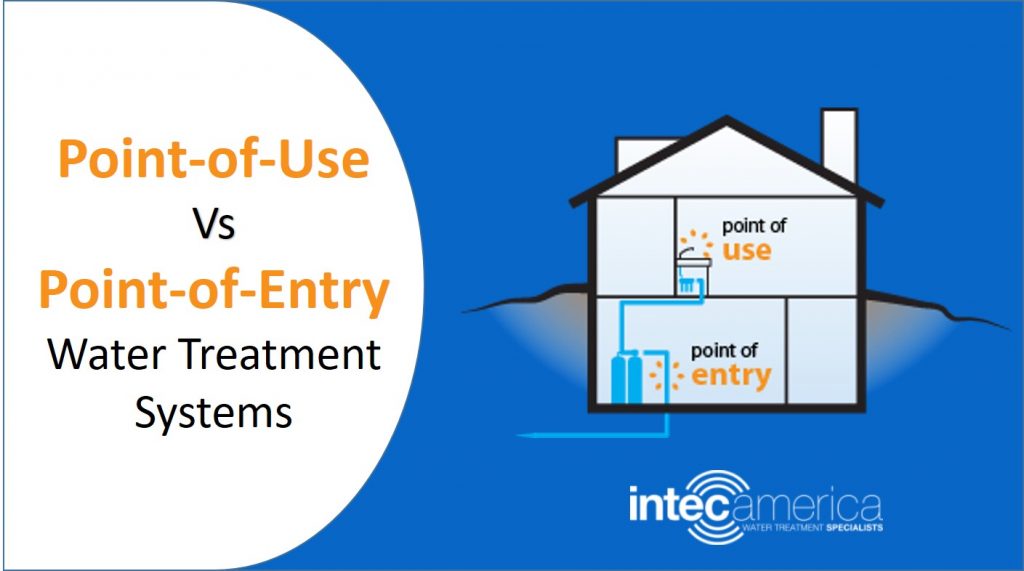Water purification is a crucial process to make it potable and fit for usage and consumption. Water collected from ground wells and other water bodies such as rivers and lakes is collected in reservoirs. At times, water purification systems are installed in a location before the water enters the home. These are point-of-entry water treatment systems. These systems can consist of a single or multiple technologies to address issues related to the incoming water. POE systems are much larger than POU system because they have to handle much higher flow rates and volumes.
Point-of use (POU) water treatment systems are usually installed just before the water is used for drinking, cooking, or perhaps a designated location in a laboratory requiring highly purified water. This post compares point-of-use and point-of-entry water treatment systems in terms of their features, benefits, and more.
What Are Point-of-Entry (POE) Water Treatment Systems?
Point-of-entry filtration systems are installed either outside before the water supply enters into households or an interior location inside of the home before the water is distributed throughout the household. POE filtration systems may comprise large carbon filters, water softening/conditioning systems, or other technologies to address chemicals, remove odor, neutralize aggressive water, or eliminate dirt and sediment. These systems make the water fit for general usage and further treatment may be required to make the water suitable for drinking or cooking.
At times, these POE pre-filtration systems, or pre-filters, can be considered level I purification systems are used before the water is again purified at a location where further specific treatment is required. If high purity water is not required throughout the home, it can greatly reduce the cost by using smaller systems downstream before the water is used. In this situation, the post treated water traverses its way to your locality where it may be purified again for a specific application.
The POE systems are usually large and durable and can last several years without requiring any major servicing. These are cost effective systems; however, routine cleaning or maintenance may be required to increase their operational life.
What Are Point-of-Use (POU) Water Treatment Systems?
As mentioned, this is a type of filtration system intended to be used at a specific location in one’s home. Many of these can be installed under a kitchen sink or directly attached to a tap or faucet. So basically, these purify the water before drinking and cooking. At this stage, typically, water is purified at least for the second time as it is already purified by the water supply department. These are essential devices in households and commercial places. These systems improve the quality of water to make it suitable for drinking. This part is taken care of by POU systems. In this case, the water consumed is treated just before its usage. The filters of these systems are usually changed once or twice a year.

Point-of-Entry or Point-of Use: Which Filtration System is Better?
The fact is that both systems come with their own benefits and one is not better than the other. Whether you should utilize point-of-entry or point-of-use depends a lot on your requirement and budget. The basic difference here is that a point-of-use system is applicable for only one tap or faucet. So, if you are looking for purifying only your drinking water to improve the taste, a POU reverse osmosis system may benefit you more. Utilizing the same technology for your entire home would be very expensive and you may not need high purify water for laundry or cleaning dishes. Modern POU systems can be installed onto your kitchen faucet to improve taste. More advanced systems use a storage tank under the sink with filters installed on an adjacent wall.
In case of a point-of-entry system, which is perhaps installed at the main supply line, all the taps and faucets in your home would receive filtered, purified water. This may be useful in case your supply line source is well water that contains heavy metals and or smelly chemical compounds. It is a known fact that hard water leaves residues, stains, and discoloration on utensils, clothes, bathtubs, and showers. In such a scenario, all the water sources in your home should receive filtered water.
Ideally, in most cases, both these systems are essential and need to be installed at their own levels.
Are you a home owner or an office space owner looking for point-of-use water filtration systems? Or are you a gated community chairperson or a water supply department officer looking for point-of-entry water filtration systems? In either cases, be sure to approach a reliable player such as Intec America, which offers safe water treatment solutions for drinking and usage. Intec America was the first company in the US to popularize the copper ionization technology developed by NASA for swimming pool and spa sanitization.
Recent Blog Posts
- Benefits and Challenges of Owning a Swimming Pool or Spa
- What is the Best Chlorine-free Treatment for Your Swimming Pool?
- Guide to Water Softener Issues, Maintenance Tips, and Replacement
- Hot Tub Chlorine Alternatives: What is Right for You
- Water Softener Vs Reverse Osmosis: What is Right Your Application?
- How to Install Water Filters?
- TDS Measurement: All Important Questions Answered
- What Are the Benefits of Using Soft Water for Domestic Consumption?
- How Often Should You Clean a Swimming Pool?
- Opening your Pool
- How to Prepare Your Swimming Pool for Summer?
- How Often Should You Test Your Pool Water?
- 9 Healthier Alternatives to Chlorine for Swimming Pools
- Swimming Pools and Turtles – Yes We Handle Anything/Everything
- Unintentional Drownings: How to Protect Your Family
- How to Get Rid of Water Bugs
- Are You Sensitive to Swimming Pool Chemicals


